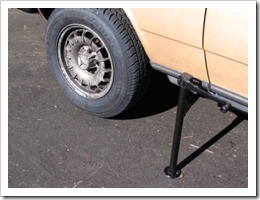A Flat Tyre Posted by Serena on Dec 3, 2013 in Italian Language
Yesterday morning we were going to buy some milk from the supermarket, and as Geoff was parking the car next to the curb, he touched it with the edge of the tyre. We heard a scraping noise and then the car started going down on one side. “****!!!” said Geoff angrily. So he parked the car in a better place and then opened and emptied the fully loaded bagagliaio (the boot), to reveal il ruotino di scorta con gli attrezzi (the small spare tyre with the tools). As Geoff and our friend Michele (who we’d been going to meet) were changing the tyre, my mind went back to my childhood.
When I was a child my family lived in North Africa. The desert roads there were very dirty, and bucare la ruota (to puncture a wheel) was a very common event, therefore everybody knew come cambiare la ruota (how to change the tyre), even my mother! Well, she knew the theory, but for the practical side of it she had trained my two older brothers, who were about 8-10 years old: we would all get out of the car, then under my mother’s instructions Gippy and Andrea would get la ruota di scorta (spare tyre), il cric (the jack) and la chiave a croce (cross shaped wheel brace) out from il bagagliaio.
In those days il cric was a horrible long straight metal affair with a foldable ‘foot’ which you had to pull out to 90 degrees and insert in a slot underneath the car, before lifting it up, but more often then not it would bend at the wrong angle and il cric would get stuck. In the summer, with temperatures well over 40°C, the asphalt melted and the jack sank down into it. Parking the car off the road was even worse because there were no curbs … just sand.
When the jack was finally inserted, it was time to svitare i bulloni (unscrew the bolts): my brothers would fit la chiave a croce (the brace) on one of the bulloni so that it was more or less horizontal, and then my mother would order: “Salta!” (Jump!) and they would take it in turns to jump onto the brace until the bolt started to turn. From there on things were much easier: once the bolts were removed they would lift the car a bit higher, swap the wheel, which it often involved getting their sleeves caught in the parafango (mudguard, do you remember those flimsy old mudguards made out of sharp tin?), lower the car and then go back to the jumping exercise to tighten the bolts. With the show over we all got back in the car and then went straight to il gommista (the tyre repairer) to get the tyre fixed before the next puncture. Ah, i bei tempi andati! (Ah, the good old days!).
Some useful vocabulary:
la ruota di scorta = the spare wheel
bucare una ruota = to puncture a wheel
la gomma/il pneumatico = the tyre
avere una ruota a terra = to have a flat tyre
il telaio = the chassis
il parafango = the mudguard
il cric = the jack
la chiave = the wheel brace
i bulloni = the bolts
svitare = to unscrew
avvitare = the screw up/tighten
il gommista = the tyre repairer
far riparare la gomma = have the tyre repaired
gonfiare la gomma = to inflate the tyre
… and unfortunately in our case: “purtroppo questa gomma non si può riparare, dovete comprarne una nuova” dice il gommista … “porca miseria!” dice Geoff

Build vocabulary, practice pronunciation, and more with Transparent Language Online. Available anytime, anywhere, on any device.





Comments:
Phil:
Serena,
A wonderful story of your childhood. I would recommend one technical change to your blog. In English, you don’t puncture the wheel. The wheel is the metal piece bolted to the axle. The tire (tyre) is the part which can be punctured. The tire is mounted on the wheel and the wheel is then mounted on the axle.
I love your stories and the help you provide. Thanks.
Phil
Geoff:
@Phil Thanks for your comment Phil. You are perfectly correct that, technically speaking, it’s the tyre that gets punctured, and not the wheel, and I’m aware that this differentiation is made in English. However, in Italian the terms gomma and ruota are frequently interchanged. We commonly say ‘ho una ruota a terra’ = ‘I’ve got a wheel on the ground’ to mean ‘I’ve got a flat tyre’, and ‘mannaggia, ho buccato una ruota!’ = ‘damn, I’ve punctured a wheel!’
When I’ve got a few minutes I’ll update the blog to include both ‘wheel’ and ‘tyre’ in the translations, va bene?
Grazie, a presto, Serena